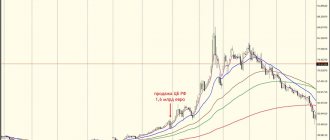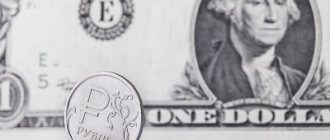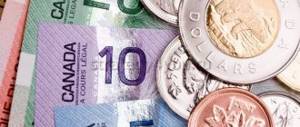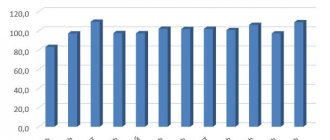03/18/2021 490 0 Reading time: 10 min. Rating:
Author
: Konstantin Bely
Let's talk about what the dollar is backed by . There is a widespread opinion that the dollar is not backed by anything, it is just “pieces of paper” that are printed by the “private office” of the Fed in any endless quantity. People who are far from the financial and economic sphere love to spread this myth, and if they also dislike the United States and everything connected with it, then they spread it in the brightest colors. Now I will explain to you why this is not so, and tell you what currency backing in general and dollar backing in particular is. So, first things first.
Developed economy and financial system
The economy of the United States is an advanced modern system. This applies to technology, the volume of GDP, the status of the largest corporations, and many other factors. The economic potential allows the American dollar to maintain its status as the reserve currency of most countries in the world. The most important role here is played by the technical aspect, because an economy that has a global scale requires a large number of mutual settlements. And, of course, it is most convenient and logical to make these calculations in the currency of the country that has the most developed trade and the highest status in the world.
The States take part in all major financial processes taking place in the world and in one way or another control them, as well as the entire global financial system. Due to the volume of assets and technical equipment, the American banking system prevails over the banking sectors of all other countries. The country has a very developed variety of services, such as Mutual Funds, Money Market, Exchange-Traded Funds and others. There would be no point in creating thousands of funds if there was no demand for their work. But since the modern US financial system is so developed, the daily need for dollars is obvious.
Denominations
All US dollar notes issued since 1861 can be used as legal tender. However, only the following denominations are now freely circulated and issued:
- Banknotes: $1, $2, $5, $10, $20, $50, $100.
- Coins (cents): 1¢, 5¢, 10¢, 25¢, 50¢ and $1 coin.
In addition, $500, $1,000, $5,000, and $10,000 bills that were issued before 1945 are valid. However, their bonus value significantly exceeds their face value, since they were withdrawn from circulation with the transition to electronic bank payments in 1969. Such banknotes are considered a rarity and are bought and sold at auctions.
US dollar bills depict presidents and important government officials of the United States. The basic design of the banknotes was developed in 1928. Over time, only a few have had adjustments made.
Political and military power
No country in the world can yet compare with the United States in terms of the level of all kinds of behind-the-scenes intrigues and cunning political manipulations. At one time, the USSR successfully resisted the states, but after its cessation of existence there were no competitors left. By and large, many countries in the world live guided by American dictation, and this applies not only to the economic aspect, but also to life in general. It is not surprising that the world has adopted the dollar almost as a second currency.
Military bases located all over the world, the firepower of American military equipment, the ability to influence the internal politics of countries and seize new vast territories - this is something that no other country in the world has.
By and large, the United States simply cannot get resistance from other countries, which means that disagreement and clashes with this state are doomed to failure.
How much money should you take with you on a trip to America?
Now let's talk about how much money you need to take with you to America . In fact, this question is not simple, because everyone has their own ideas about how much they want to spend and on what. After all, you must admit, it’s one thing to live in a luxury villa in the city for the rich of Santa Barbara, on the Pacific Coast of the United States, and quite another thing to travel on a budget and stay in hostels.
So, if you are traveling to America on a package tour , then most likely you have already paid for all the travel and hotels when you bought the tour. Therefore, all you have to do is pay for food in cafes and restaurants, and buy gifts and souvenirs. I recommend targeting $50-100 per day per person, depending on the duration of your trip and the intensity of your program. Going to expensive restaurants and booking additional excursions will approximately double this amount.
- Dinner for two in a restaurant can cost 100-150 dollars, but a snack in a cafe alone can cost only 7-10 bucks (coffee and donuts or a sandwich). The average check for lunch at inexpensive restaurants is usually $12-20. If you buy food in stores and cook it yourself, it will be even cheaper, since food prices in the USA are quite low, but you always have to pay a lot for services.
- Travel by public transport in the city will cost 6-8 dollars per day.
- Visiting museums usually costs between 5 and 20 dollars, but some allow you to pay at your discretion, for example as little as $1.
- Entrance to observation decks, the zoo or a movie ticket will cost $20-40.
- Go to the theater to see a Broadway musical, buy a ticket to Disneyland or to a sporting event (hockey, basketball or baseball) - from 70 to 200 dollars.
If you are going to travel around the USA on your own , as we did (see the article about our trip to America), then I advise you to carefully work out your route in the States and roughly calculate the planned expenses. Even if you don’t spend a lot of money, you are still unlikely to be able to spend in the US, less than $1,000 per person for 2 weeks.However, if you stick to an austerity plan, you can cut costs by about half.
Important to know: In any case, a tourist in the USA will hardly be able to live on less than $250 a week. Usually thrifty people who come to America for 2-3 weeks end up spending 3-5 thousand dollars for two in the States.
Rich resources and tangible assets
In the United States, tangible assets with a total value of about $35 trillion are in private hands, while assets worth $10 trillion are managed by the public sector. As for resources, it is difficult to evaluate them in monetary terms, since they are primarily natural resources, territory and much more. And all this abundance brings constant income not only through work within state borders, but also through international trade relations, in particular due to the export of a large number of goods and services to many countries. The calculation is carried out exclusively in dollars, and thus the overall growth of the world economy contributes to an increase in demand for this currency. Governments, large public and private funds, and well-known corporations prefer to store monetary assets in dollars rather than in the currency of their country.
Recommended brokers for trading the dollar on the forex market
To trade the dollar and other currency pairs in order to make a profit on trends, a trader must first open a trading account (deposit) with one of the Forex brokers. Masterforex-V Academy has been maintaining its independent rating of Forex brokers for more than 12 years, based on more than 30 objective criteria for assessing brokers (spread and swaps, presence or absence of licenses from financial regulators, offering CFDs, NDD, STP, ECN, PAMM and LAMM accounts, opportunities opening a large number of lots and hedging them (including through a lock/lock instead of Stop Loss), the availability of financial instruments from stock, futures, cryptocurrency, currency and commodity exchanges, etc.), as well as on the reviews of the traders themselves.
As a result, out of 400 companies, we identified only 12 “best Forex brokers” of the major league and another 20 reserve companies from the 2nd league (popular companies, but with numerous complaints from clients). Here is a list of them.
| Broker name | Year of foundation | Trading instruments | Licenses | |
| Major League | ||||
| 1. | NordFX | 2008 | currency pairs, commodity futures, stock indices, cryptocurrencies, stocks | CySEC, MiFID |
| 2. | Swissquote | 1996 | commodity futures, currency pairs, stock index futures, cryptocurrencies, metals, ETFs, warrants, shares | FINMA, FCA, SFC, Dubai FSA |
| 3. | Dukascopy | 1998 | stock indices, commodity futures, currency pairs, stocks, bonds, ETFs | FINMA, FCMC |
| 4. | Alpari | 1998 | metals, energy, indices, currency pairs, cryptocurrencies | ARFIN |
| 5. | FxPro | 2006 | indices, commodity futures, stocks, currency pairs | FCA, CySEC, FSB, Dubai FSA, BaFin, ACPR, CNMV |
| 6. | Interactive Brokers | 1977 | stocks, bonds, derivatives, currency pairs, forward contracts, bills, warrants, options, stock indices, currency and commodity futures | NFA, CFTC, FCA, IIROC |
| 7. | Oanda | 1996 | bonds, stock indices, currency pairs, commodity futures | NFA, CFTC, FCA, IIROC, MAS, ASIC |
| 8. | FXCM | 1999 | currency pairs, stock indices, commodity futures, cryptocurrencies | FCA, BaFin, ACPR, AMF, Dubai FSA,SFC, ISA, ASIC, FSB |
| 9. | Saxo Bank | 1992 | currency and commodity futures, stock indices, currency pairs, ETFs, stocks, bonds, derivatives | Danish FSA, Consob, Czech National Bank, Bank of the Netherlands, ASIC, Monetary Authority of Singapore, FINMA, Bank of France, Central Bank of the UAE, Japanese Financial Services Agency, Securities and Futures Commission in Hong Kong. |
| 10. | FOREX.com | 1999 | currency pairs, stocks, stock indices, commodity futures, cryptocurrencies | NFA, CFTC, FCA, ASIC, JSDA, MAS, SFC |
| 11. | FIBO Group | 1998 | metals, energy, currency pairs, commodities, cryptocurrencies, indices | CySEC |
| 12. | FINAM FOREX | 1994 | currency pairs | Bank of Russia |
| Second League | ||||
| 13. | Forex Club | 1997 | currency pairs, indices, commodities, stocks, ETFs | ARFIN |
| 14. | TeleTrade | 1994 | commodities, currency pairs, indices, stocks | ARFIN |
| 15. | ActivTrades | 2001 | indices, commodities, currency pairs, stocks, bonds, ETFs, cryptocurrencies, options | FCA, SCB |
| 16 | FreshForex (Fresh Forex) | 2004 | indices, commodities, stocks, currency pairs | — |
| 17. | eToro (eToro) | 2007 | currency pairs, indices, commodities, stocks, ETFs, cryptocurrencies | ASIC, FCA, CySEC |
| 18. | FortFS | 2010 | currency futures, currency pairs, indices, commodities, bonds, stocks, cryptocurrencies, ETFs | IFSC Belize |
| 19. | 2011 | currency pairs, indices, commodities, stocks | ASIC, IFSC, CySEC | |
| 20. | BCS Forex (BCS Forex) | 2004 | currency pairs, stocks, indices, commodities | — |
| 21. | GKFX | 2009 | currency pairs, indices, commodities | FCA, JFSA, DMCC, BaFin, AMF, AFM, Consob, CNMV, , CNB, Národná Banka Slovenska |
| 22. | NPBFX (Nefteprombank) | 2016 | commodities, currency pairs, cryptocurrencies | — |
| 23. | Admiral Markets | 2001 | cryptocurrencies, currency pairs, commodities, stocks, ETFs, indices, bonds | ASIC, FCA, EFSA, CySEC |
| 24. | Grand Capital (Grand Capital) | 2006 | stocks, indices, commodities, cryptocurrencies | — |
| 25. | RoboForex (Roboforex) | 2009 | indices, commodities, currency pairs, stocks, cryptocurrencies | CySEC, IFSC Belize |
| 26. | FinmaxFX | 2018 | currency pairs, indices, commodities, bonds, stocks, options | CROFR, VFSC Vanuatu |
| 27. | FXOpen | 2005 | indices, commodities, cryptocurrencies, currency pairs, | FCA |
| 27. | Forex Optimum Group Limited | 2009 | indices, commodities, currency pairs, stocks | — |
| 29. | EXNESS | 2008 | commodities, currency pairs, cryptocurrencies | FSA Seychelles |
| 30. | HYCM | 1989 | indices, commodities, currency pairs, stocks, cryptocurrencies | FCA, CySEC, CIMA, Dubai FSA |
| 31. | Alfa Forex (Alfa Bank) | 2003 | currency pairs | Bank of Russia |
| 32. | Forex4you (Forex fo you) | 2007 | stocks, indices, currency pairs, commodities, cryptocurrencies | FSC BVI |
Sincerely, wiki Masterforex-V, free (school) and professional training courses Masterforex-V.
Stability over many years
When investing in foreign currencies, such as dollars, the consumer rightfully wants to receive guarantees that unforeseen situations will not happen to his money. To do this, the currency must have a sufficient level of stability, proven over decades. The consumer must know for sure that this currency will not be taken out of circulation and will not be subject to redenomination. The Russian ruble cannot boast of the complete trust of citizens, because over the past two decades, Russians have experienced the negative experience of two defaults, one of which occurred in 1991-1992, and the second in 1998. The ruble of the 1999-2008 model also did not deserve a positive reputation, since its image was thoroughly damaged at the end of 2008 and beginning of 2009 during the partial default. At that time, a 40% devaluation occurred, which once again undermined Russians' confidence in their currency, as prices in the country rose sharply as a result of these problems.
Not only the ruble, but also the currencies of many other countries underwent serious changes in the course of historical events, some of its types even managed to completely go out of circulation. No currency other than the dollar has remained virtually unchanged for many decades in a row. For example, now not only Soviet rubles, but also French francs have long sunk into oblivion, and if you go to a store with them, they will not be accepted for payment, and their owner will be mistaken for a madman. But if you find dollar bills from the early 20th century and try to pay for your purchases with them, then no problems will arise. But the dollar began its history much earlier than the Soviet ruble.
Cash in America
Cash in America will definitely come in handy when buying souvenirs during various excursions, as well as for paying for transport fares (they don’t give change there) and using machines in the parking lot or terminals that accept only cash payments. Therefore, stock up on small bills and get coins as soon as possible (dimes and quarters will be especially useful). In addition, $300-500 set aside in advance in your wallet just in case can help you when traveling around the USA if the money on the card suddenly runs out or it is blocked by mistake at your bank.
Experienced tourists advise taking with them several bank cards (debit and credit) issued by trusted banks. It is better to use a credit card for deposits (for example, when renting a car), and a debit card can be used to pay in hotels and restaurants, as well as for everyday purchases.
Recommendation
By the way, you can book an inexpensive car for a trip around the USA and pick it up where it’s convenient for you (for example, at the airport upon arrival, or have it driven directly to your hotel for free) on the trusted car selection and rental website Rentalcars.com →
Cash out in the USA
If you urgently need a small amount of cash in the USA, and there is no ATM or bank branch nearby, then it is worth keeping in mind that in America you can cash out dollars directly in a regular store or supermarket. This service is called cash out . All that is required for this is that when paying for goods at the checkout with a plastic card, request simultaneous withdrawal of the amount you need from it.
An amount of up to $20 will be given at the checkout without any questions, and if you want to get more cash, you will need to provide a passport to identify you. In addition, not all stores provide such a service, and it is not provided with all cards of foreign banks. In any case, there is such a possibility, and you can find out on the spot whether a particular bank card is suitable for this.
Travel checks
Anyone who is going on a trip to the USA and does not want to carry a wad of money with them will find it useful to learn about another method of non-cash payment - traveler's checks. Travel checks in US dollars can be cashed at hotels, large stores and restaurants (American Express, Visa and Thomas Cook checks are accepted quite easily, but others are a matter of luck). And although it is believed that this method of transporting money is already quite archaic, nevertheless, its main advantage compared to cash currency is protection against loss or theft (it can be quickly restored). In addition, a traveler's check, unlike a bank card, will definitely not be blocked by anyone.
Dollar debts
One of the decisive factors that guarantees the long-term stable existence of the American dollar is the huge amounts issued on credit to American companies and individuals. The state will not be able to cancel the currency in which the population's debts are concentrated. The money should return to the hands of the state bank, bringing with it a solid income in the form of interest, penalties and various commissions. And while banks are waiting for the return of their funds, Americans are taking out new loans for their needs, thereby reinforcing the stability of the dollar. Both parties can be completely confident that the national currency of their state will not change its value and will not cease to exist. Together with them, leaders of other states and their citizens gain this confidence.
Low inflation
If a currency has a serious tendency to depreciate, it will never be able to achieve reserve status. For any state, such a situation is simply not profitable and even dangerous for the economy. Large sums of money, especially on the scale of an entire power, do not tolerate a precarious situation. A certain percentage of inflation is acceptable, but it can only be minimal. But a stable currency that is resistant to unpredictable situations, such as the dollar, is an excellent option for storing capital of any size. Central banks carefully monitor inflation indicators of world currencies.
These days, the issue of maintaining the value of a currency is one of trust and economic sustainability. The stability of prices for goods and services in a country is an indicator by which a stable and trustworthy currency can be determined. The stability of dollars and the low rate of their depreciation positively characterize the entire financial system of the state, and a good reputation increases confidence in both the country’s currency and its leaders.
Tipping in the USA (tips)
Finally, I will try to briefly talk about tipping in the USA, although this topic is actually quite extensive, and you first need to get to know the culture and traditions that have developed in America better before discussing when you should pay a tip and when you should not leave them (perhaps , they will be included in your final bill). So I'll get straight to the point.
So, tips in America (they are called tips in English) are usually paid almost everywhere, for any service that is provided exclusively to you. Moreover, the “tip” amount is included in the final bill before taxes are calculated, so keep in mind that the total will be even higher. It is also worth keeping in mind that it is not customary to leave tips for medical services, as well as for government workers and employees; this may even be regarded by them as a small bribe.
Good to know: Tips are usually not included in the bill, but forgetting to leave them is not accepted in the United States (it is considered bad manners and can be perceived very negatively). Their size is left at the discretion of the client. In hotels, it is customary to tip the maids (if you are staying for several days) and the butler serving you, as well as when ordering food in your room. In expensive restaurants, the tip amount is usually 15-20%, and in large cities like New York or Los Angeles, the minimum tip amount may be higher.
Before leaving the restaurant, if you pay in cash, it is customary to simply leave the amount on the table without change, including a tip. If you are going to pay with a credit card, the waiter will bring you a bill, where the amount of the ordered dishes has already been entered and there are two more empty lines. One of them is the “tips” line, which the client must fill in, and the second must be filled in with the total amount (total), and it is not recommended to leave it empty, otherwise restaurant employees can fill it out without the client’s knowledge, indicating an increased amount.
In cafes and fast food restaurants, it is not customary to pay tips, although you can put your change in a special tip collection box located next to the cash register.
In a taxi, at the end of the trip, when paying with a card, you must first select the tip size (15, 20, 25 percent of the metered fare or more), and you won’t be able to pay at all or refuse to tip the taxi driver, since he doesn’t accept cash.
Here is the tip size that is customary to leave in the USA for various services:
- In a restaurant – 15-25%
- For a taxi ride - 15-25% and $1-2 for each piece of luggage
- Porter – $1-2 for each item
- Maid – 2-5 dollars daily
- To the waiter for room service – 15-20% of the bill amount
- Bartender – $1-2 for each approach or 15% of the bill amount
- Hairdresser or massage therapist in a beauty salon – 10-15% of the cost of services provided
- Instructor at the ski resort – 10% of the cost of services or payment for lunch
- Courier (pizza home delivery, etc.) – 10-15% of the order value, usually 2-5 dollars
Maximum degree of trust
Everyone has become accustomed to the fact that the dollar is our constant companion; no one has any desire to use another currency. Once in any country in the world, you can pay for your purchases in dollars and with a 99% probability this money will be accepted by the cashier. With other money this is not possible. The preference to deal with the American dollar applies not only to tourism and shopping. For example, a large percentage of the population of many countries, including Russia, would agree to receive wages in this currency rather than in the currency of their country. So, no matter how paradoxical it may be, it can be argued that the US dollar is backed by the need for itself. People of any profession, nationality and status want to use dollars.
Another currency, for example, the euro, can hardly claim to be a reserve currency, because all European countries have their own interests and have different financial and economic reserves. In addition, the euro is used in circulation only in the European part of the world, and storing capital in European currency would be illogical and rather inconvenient for countries in Asia or South America.
Mass consumption
The domestic market contributes to the fact that Russians are accustomed to the dominance of monopolism. It is quite difficult for the average person to understand that in the modern economy, dominance belongs to the consumer. In the minds of our compatriots, the concept is firmly established in which the producer controls the market, and consumption already depends on what is offered on the market. However, it is not for nothing that there is a correct opinion that demand creates supply, and the modern global market assigns the leading role to the consumer. It doesn’t matter what product or service we are talking about; in all countries of the world, the seller’s pricing policy is formed in accordance with the financial capabilities and needs of the potential buyer.
Given that the US is the world's largest consumer, the dollar has support. Of course, consumption must be supported by stability, a stable political and economic system, political strength and other positive factors, but, as mentioned above, this state has all this.
Having analyzed all the points of this article, we can safely say that the dollar will continue to retain its status as the main world currency. Perhaps in the future another wave of crisis could shake the American financial system, but the likelihood of this is very low. So far, there is no alternative to the dollar as a reserve currency, since the backing of the US dollar is very impressive and significant.
What does the dollar exchange rate depend on?
Let's consider the factors that influence the exchange rate of American money in the market. First of all, the dollar is a freely convertible currency. How did this happen?
The system installed after the conference functioned for about 30 years. During this period, the United States could freely exchange dollars for gold. However, due to a sharp decrease in the supply of this metal, the American authorities were forced to look for a replacement for such a system. So, since the mid-70s, a different approach has been used in the world. It relies on:
- a move away from gold as a guarantor of exchange rates;
- free convertibility of money.
Thus, from that moment on, the exchange rate is generally determined by the magnitude of supply and demand.
The exchange rate is also influenced by: the geographical position of the country on the map, the introduction of sanctions, a decrease or increase in oil prices, and the internal political situation. All this, to varying degrees, affects the increase and decrease in the price of the dollar.











